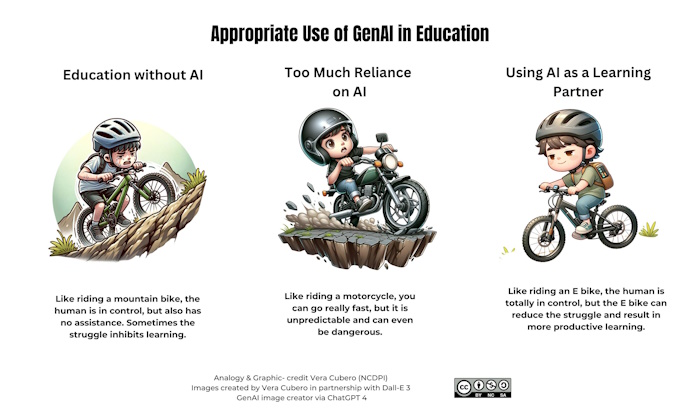
Return to Digital Literacy Web Agenda
February 4, 2025
Wake County teachers pioneering use of AI |
Be My Eyes Accessibility with GPT-4o https://www.bemyeyes.com/ |
A paraplegic athlete carried the Olympic flame, made possible by an AI-powered exoskeleton |
- Sign in, stowe your other devices, and log into a Chromebook. Complete the While You Are Waiting (WYAW) activities (including attendance!)
- Flippity Lesson Plan Overview: Canvas and an excellent example
- Generative AI! What is it and what will it mean for education?
https://docs.google.com/presentation/d/1gvkkyU0ZdNEbwbCcETEsf1Axv7jw4e_t_IG4jasDHKI/edit?usp=sharing
- The most well known Generative AI tools are Microsoft Co-Pilot with Data Protection (installation instructions here), Chat GPT (https://openai.com/blog/chatgpt/), and Gemini (https://gemini.google.com/) but there are better tools for teachers using more friendly interfaces called "wrappers".
NOTE: Remember that you are not required to use any of these tools and the WCU endorsed AI tool is Co-Pilot with Commercial Data Protection (see link above). These are being shown to you to help you be informed as a current and future teacher. AI, it's a thing.....
Let's explore these. You may observe if you wish or if you choose to participate, use your class gmail account. Using these tools to compare/contrast how to create a (basic, kinda boring) lesson plan that can serve as a framework for *your* creative lesson plan, create the same lesson using details from a lesson you'll teach.
Here's a sample prompt you can try:
- MyLessonPal (free sign up) https://mylessonpal.com/
- Magic School (free sign up) https://www.magicschool.ai/
- School AI (free sign up) https://schoolai.com/
- Table Groups: At your table, discuss these questions and be prepared to share. Consider the ethical implications of using AI in the classroom....
- Who should have access and will this happen at school?
- Will it enhance critical thinking in students or reduce it? What are appropriate actions when AI gets it wrong? How do we know? Will we need fact checking and triangulation of information (e.g., comparing more than one source to verify)?
- Is there a worry about over reliance on these tools?
- Since it draws from public information on the internet how do we give credit for who did the work and came up with original ideas, art, etc.? (Plagiarism and Intellectual Property)
- North Carolina is a leader in AI in education and has responded quickly yet thoughtfully. Let's take a look at our state's AI Guidelines for School Systems, Schools, and Classrooms: https://go.ncdpi.gov/AI_Guidelines
- It's scary how much AI can do and it's rapidly evolving at a dizzying speed! Here's an example of a different kind of audio than a podcast and an image different from a classic animated cartoon.
The Classic Cartoon Adobe Firefly (images and more)
https://firefly.adobe.com/Suno.ai
https://suno.com/ https://vimeo.com/manage/videos/1053236842
- Some more to try as you create your AI Portfolio - Let's check out the list and assignment in Canvas. Deepfake!
- LAST WORDS.....

RESOURCES:
A very comprehensive, thought-provoking, and informative presentation on AI from Vera Cubero at NCDPI https://www.canva.com/design/DAGFm6FMxsM/TcJdbQrf4qJ5vJXk2EVKpw/edit
A spreadsheet of resources from NCDPI on AI including Webinars and Presentations
https://www.dpi.nc.gov/districts-schools/districts-schools-support/digital-teaching-and-learning/ai-resources